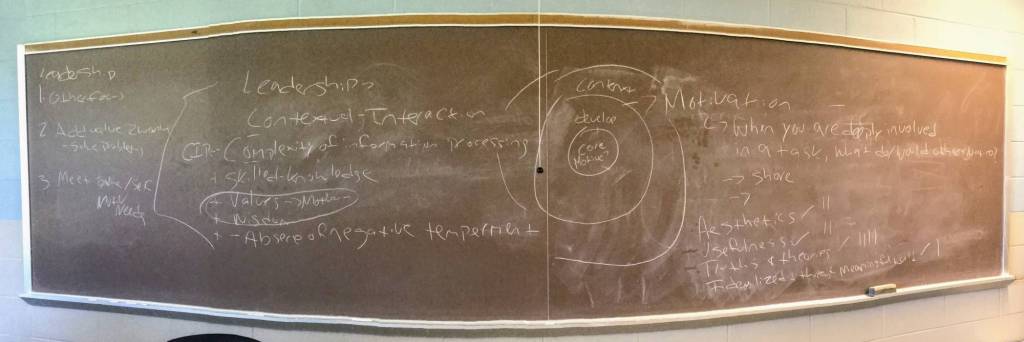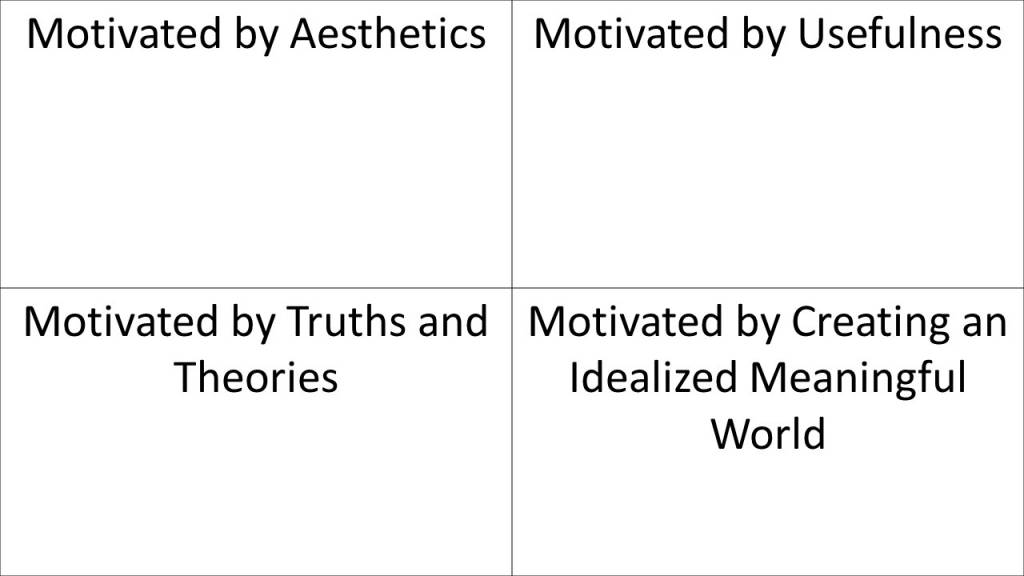
Are leaders’ motivations different than others?
No, they are not. The term ‘leader’ is another way to say a helpful person when you need help. I had this discussion in Buffalo, NY, with a series of workshops focused on leadership. Above is a picture of the chalkboard at the end of a seminar called “What Motivates you? What motivates others?”
The idea of people seeing, interpreting, and being motivated by different core, developmental, and behavioral influences kept coming up within the discussions.
Leadership is contextual interaction
Leadership is dependent upon the environment:
- Leadership happens through people within a specific context (i.e., work, sports, hiking, cooking) and two or more people interacting (someone has the knowledge to share, and someone has to find that experience helpful).
Leadership focuses on others:
- Leadership is not about you or your introspective wonder but about how others react and respond – extrospection.
- This other focus supports self-reflection and developing the wisdom to change how you work with others and be best supported in achieving organizational and personal goals. Other-focus happens before self-focus.
Leadership is fulfilling other’s motivation while keeping your motivation needs met:
- Understanding what motivates someone else and keeping their motivation full is what good leaders do.
- Also, knowing what motivates you and how you can fulfill your self-motivation will keep the extrospection healthy and focused.
In the class, we broke leadership motivation into 4 Categories. This discussion was supported using a behavior lens called Essential Motivators by Matrix Insights.

Motivated by Aesthetics – those who want the work and outcomes to look as good as possible. We came up with a Steve Jobs example and the story of how Jobs wanted the inside of the Mac to look as good as the inside. Another student shared that when she feels overwhelmed writing a paper, she finds motivation to work on the paragraph’s indentation, the font and font size, and the look of the paper.
Motivated by Usefulness – those that want the work and the outcome to be useful, a more pragmatic motivation. The class discussed that people in this category are motivated to ensure that the product gets used in a way people value. An example would be an engineer who designed a cheap car that did not look that good but was affordable, and people could use it.
Motivated by Truths and Theories – those seeking research know that what they share is the most accurate and aligned with a set of agreed-upon principles on which the work and outcomes are based. The class discussed a researcher who enjoys reading through journals and papers to create and share an improved or new way of doing the work.
Motivated by creating an Idealized Meaningful World – those who want to improve the world and dream of how the work and outcomes will improve the world. The class discussed someone in a nonprofit or helping profession who believes in social equality and is motivated to improve the world.
We found the discussion of leadership motivation to be most helpful by framing the following discussion-based activity:
Leadership Motivation Discussion
- Choose a current challenge you are having with another person
- Try to categorize the other person’s motivation.
- Share an example of when you have seen this be helpful, and share an example of when you have seen this be hurtful.
- Try to categorize your motivation.
- Share an example of when you have seen this be helpful, and share an example of when you have seen this be hurtful.
- Identify 1 to 3 ideas for approaching this person differently, supporting their motivation needs.
- When one of your ideas works well, what will you do differently? What will the other person be doing differently?
Many of the students found this discussion helpful.

